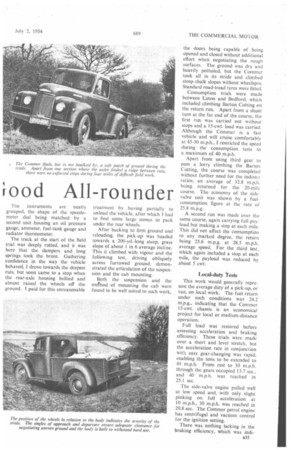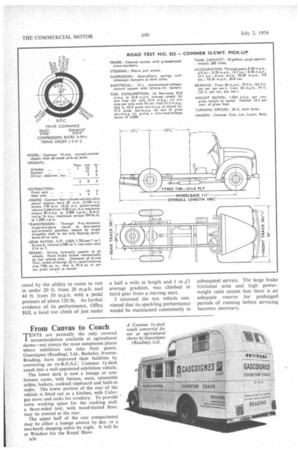Commer 15 cwt. a All-rounder
Page 80

Page 81

Page 82

If you've noticed an error in this article please click here to report it so we can fix it.
Medium-duty Pick-up is Tried Across country where Adequate Power is Found Available for Such Work : Suspension Provides Smooth Riding Over Rough Ground
By Laurence J. Cotton, M.I.R.T.E. THE Commer 15-cwt. pick-up is a good all-purpose vehicle which combines economy with spirited performance. The soft but welldamped suspension provides for comfortable cross-country driving. It is an excellent type for emergencyrepair-gang work, being fast and having the ability to carry a full 15-cwt. payload or more, and is a handy general-purpose vehicle for the farmer. The tests indicated that with a van body fitted, the 15-cwt. chassis would also be an economical unit for local delivery work.
An ample margin in strength and power is provided by using many components common to the 25-cwt. range, this including the side-valve engine with chromium-plated cylinder bores, the 9-in, clutch and fourspeed synchromesh gearbox. The engine, of 2.266-litre capacity, develops 50 b.h.p. at 3,200 r.p.m., and 104 lb.-ft.-torque is derived at 1,600 r.p.m. The torque curve indicates good pulling characteristics from 1,000 r.p.m. upwards, and this was shown when making delayed gear changes during the trials.
Synchromesh action is provided for the top three ratios of the gearbox, the second and third ratios having helical constant-mesh gears. I found the gear selection positive and foolproof, requiring no skill to make noiseless changes. Provision is made on the side of the box to operate a power-driven auxiliary.
Fuel-tank Protection
Unusual features of the 15-cwt. pick-up include a fully floating rear axle, of sturdy proportions, doubleacting telescopic shock absorbers front and rear, and an under-seat petrol tank. With the petrol tank mounted between the main-frame longitudinals it is less vulnerable to damage on cross-country work, whilst the arrangement permits wide, full-length running boards to be used. These are an asset in field work where men and equipment may have to be given a " lift."
The all-metal body is devoid of obstruction, having external wings, but has adequate floor space for a bulky load. Sacks of clinker and building rubble formed the payload for the test, and although of awkward shape for neat stacking, they were accommodated practically within the depth of the body.
At the weighbridge the distribution of total load was found to be about 60 per cent. on the rear axle, imposing about 2 cwt. above the advocated load on a tyre of 7.00-in. section and 6-ply rating. For operators who 034 intend carrying 15-cwt. payloads full time, it might be preferable to fit covers of 8-ply rating, as these have a recommended load capacity of up to 14i cwt. It is, however, unusual for vehicles of this type to be loaded to their maximum, and for general purposes the 6-ply cover should prove adequate. After a Mann Egerton fuel-test tank had been fitted in the cab, the Cornmer was headed towards a local site for off-the-road trials. En route 1 noticed recent improvements, such as the p.v.c. interior trimming to the cab, moulded head lining to the roof, a two-piece seat squab and a rubber floor covering with felt underlay. The instruments are neatly grouped, the shape of the speedometer dial being matched by a second unit housing an oil pressure gauge, ammeter, fuel-tank gauge and radiator thermometer.
The track at the start of the field trial was deeply rutted, and it was here that the dampers and long springs took the brunt. Gathering confidence in the way the vehicle behaved, I drove towards the deepest ruts, but soon came to a stop when the rear-axle housing bellied and almost raised the wheels off the ground. I paid for this unreasonable
treatment by having partially to unload the vehicle, after which I had to find some large stones to pack under the rear wheels.
After backing to firm ground and reloading, the pick-up was headed towards a 200-yd.-long -steep, grass slope of about 1 in 6 average incline. This it climbed with vigour and the following test, driving obliquely across furrowed ground, demonstrated the articulation of the suspension and the cab mounting.
Both the suspension and the method of mounting the cab were found to be well suited to such work, the doors being capable of being opened and closed without additional effort when negotiating the rough surfaces. The ground was dry and heavily potholed, but the Commer took all in its stride and climbed steep chalk slopes without wheelspin. Standard road-tread tyres were fitted.
Consumption trials were made between Luton and Bedford, which included climbing Barton Cutting on the return run. Apart from a shunt turn at the far end of the course, the first run was carried out without stops and a 15-cwt. load was carried. Although the Commer is a fast vehicle and will cruise comfortably at 45-50 m.p.h., I restricted the speed during the consumption tests to a maximum of 40 m.p.h.
Apart from -using third gear to pass a lorry climbing the Barton Cutting, the course was completed without further need for the indirect ratios, an average of 32.8 m.p.h. being returned for the 20-mile course, The economy of the sidevalve unit was shown by a fuelconsumption figure at the rate of 25,8 m.p.g.
A second run was made over the same course, again carrying full payload but making a stop at each mile. This did not affect the consumption to any marked degree, the return being 23.6 m.p.g. at 28.3 m.p.h. average speed. For the third test, which again included a stop at each mile, the payload was reduced by about 5 cwt.
Local-duty Tests
This work would generally represent the average duty of a pick-up, or van, on local work. The fuel return under such conditions was 24.2 m.p.g., indicating that the Commer 15-cwt chassis is an economical project for local or medium-distance operation.
Full load was restored before assessing acceleration and braking efficiency. These trials were made over a short and level stretch, but the acceleration rate in conjunction with easy gear-changing was rapid. enabling the tests to be extended to 40 m.p.h. From rest to 30 m.p.h. through the gears occupied 13.7 sec., and 40 m.p.h. was reached in 25.1 sec.
The side-valve engine pulled well at low speed and, with only slight pinking on full acceleration at 10 m.p.h., 30 m.p.h. was reached in 20.8 sec. The Commer petrol engine has centrifugal and vacuum control for the ignition setting.
There was nothing lacking in the braking efficiency, which was indiB35
cated by the ability to come to rest in under 20 ft. from 20 m.p.h. and 44 ft. from 30 m.p.h. with a pedal pressure of about 120 lb As further evidence of its performance, Wiley Hill, a local test climb of just under
a half a mile in length and 1 in ,13 average gradient, was climbed in third gear from a moving start.
I returned the test vehicle convinced that its sparkling performance would be maintained consistently in subsequent service. The large brake frictional area and high powerweight ratio ensure that there is an adequate reserve for prolonged periods of running before servicing becomes necessary.








































































































































